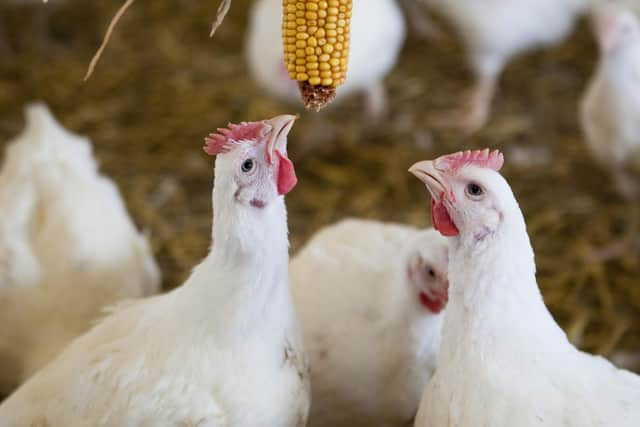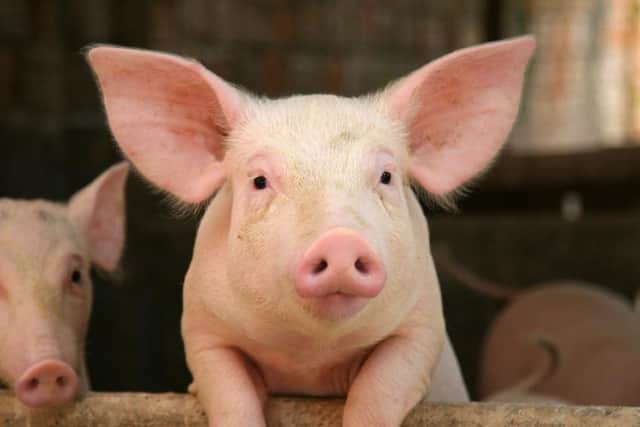It’s been an eventful few days for pigs and poultry
and live on Freeview channel 276
And there is strong evidence pointing to the same level of achievement being obtained in Northern Ireland as well.
This is a staggering increase in performance, made all the more remarkable by the fact that pig producers were probably losing fortunes of money for most of this period.
Advertisement
Advertisement
The figures were unveiled at the recent Teagasc annual pig conference.


No doubt all of this improved efficiency is helping to improve pig farmers’ bottom line.
But in many ways, the real question is this: what has it done to reduce the carbon footprint, notched up on Irish pig units?
It would be interesting to see, for example, does an increase in the number of live pigs produced have a proportionate impact on the overall efficiency of the businesses concerned?
Advertisement
Advertisement
If this is the case, then – hopefully – one can assume that the downward impact on carbon footprint will be of a commensurate level.


Meanwhile, the issue of animal welfare standards remains a very relevant subject for Ireland’s entire pig sector to address.
The Teagasc conference provided attending delegates with a perspective on how pig farmers in Finland address this critically important subject.
For example, the tail docking of pigs has been banned in the country since 2003.
Advertisement
Advertisement
Moreover, welfare in the Finnish pork production is stimulated and regulated by the Finnish government.
To encourage pig producers to invest in animal welfare, subsidies are made available.
For example, welfare improving investments are generally subsidised to the tune of 30%.
A number of production-related support systems are also made available by the Finnish government.
Advertisement
Advertisement
These include a free-farrowing subsidy of €250 /sow/year and an intact tail subsidy of €21/ finisher place/year.
This latter subsidy is given when less than 5% of the finishers have tail wounds at slaughter.
Obviously, the Finnish authorities have decided to prioritise an element of national funding to support the country’s pig industry.
So, there is no reason why the UK cannot follow this lead.
For four decades and more, the pig industry was kept totally outside the European Union support loop, purely on the back of Brussels’ dogma – where this matter was concerned.
Advertisement
Advertisement
But with Brexit now a reality, there is no reasn why the pig sector in Northern Ireland cannot receive specific farm-support measures.
However, while the approach being taken with pig farmers by the Finnish government is to be commended, it is also worth pointing out that much of the ground-breaking research on providing enriched environments for pigs was actually carried out here in Northern Ireland.
Production standards
There has been a lot of talk this week about a possible gap developing in the production standards recognised by the United Kingdom (UK) and the European Union (EU) in the context of the Windsor Framework and its possible out workings.
No doubt these are all very important issues.
But of even more significance, from a practical farming perspective, is the gap that has already become apparent in the UK versus EU farm support levels.
Advertisement
Advertisement
And, in truth, our European colleagues are very much in the box seat – where these matters are concerned.
The last review of the Common Agricultural Policy (CAP) saw the retention of the single payment scheme in its entirety plus the confirmation of enhanced ‘Tier 2’ measures.
It all adds up to a scenario within which EU farmers have full security in terms of the guaranteed support measures available to them in tandem with more flexibility for individual member states to top these measures up with national funds.
But it’s coming closer to home that we now see the aforementioned gap in support payments becoming an absolute chasm.
Advertisement
Advertisement
The recent Irish Budget saw the Dublin government agree additional funding for the arable (tillage), sucker beef and sheep sectors.
These are all additional contributions from the Irish Exchequer, over and above what is available under the new CAP Pillar 1 payments.
As a consequence, Ireland’s Sheep Improvement Scheme – essentially a headage payment to improve the welfare of ewes and lambs - has been significantly bolstered.
For the record, there is no comparable support system on-offer in Northern Ireland.
Advertisement
Advertisement
Moreover, the likelihood of getting any form of sheep support agreed for flock owners in this part of the world remains very unlikely, at least in the short term.
The Irish Budget also saw a new €200/head suckler cow payment agreed while additional provision was provided to support those arable farmers who incurred heavy, weather-related losses in 2023.
One could argue strongly that suckler and arable farmers in Northern Ireland are equally deserving of such support measures.
However, it’s highly unlikely that such a reality will come to pass.
Advertisement
Advertisement
So yes, indeed, agriculture in Northern Ireland now finds itself relegated from the top table, relative to the support levels that it actually deserves!
NGOs
Meanwhile, a leading representative of the international poultry sector is confirming that Non Governmental Organisations (NGOs) are now extremely influential in determining farming policies followed at an international level.
According to Aviagen director, Tim Burnside, NGOs are now directly impacting on farm-related decisions taken by both the European Union and the United Nations.
He spoke at the recent 2023 Poultry Industry Education Trust annual conference.
Advertisement
Advertisement
The event was held at the Loughry campus of the College of Agriculture, Food and Rural Enterprise (CAFRE)
Making much of this happen, according to Burnside is the ‘not-for-profit funding body’: Open Philanthropy (OP).
The founders of the organisation include Dustin Moskovitz, of Facebook fame, and his wife Cari Tuna.
Over the past seven years OP has made available grants totalling $300M to fund NGOs addressing issues that relate to animal welfare and other aspects of farm management.
Advertisement
Advertisement
Specifically, 39% of this money has been used to investigate matters that impact directly on the poultry sector with a further 11% used to fund projects relating to the development of meat alternatives.
Burnside continued:
“Open Philanthropy has directed 22% of these monies towards the European Union. This amounts to $63M.
“In contrast the European poultry sector has directed $600,000 in funding related activities.
“NGOs are pushing the international debate on farming systems." Meanwhile, the poultry sector is playing catch up.
Advertisement
Advertisement
Burnside referenced the disconnect that currently exists between production agriculture and the general consumer.
He added:
“The reality is that the poultry sector has a tremendously positive story to tell.
"And all of this is science-based. But the general public are not getting to hear it.
“This situation must be actively addressed by the poultry industry.”
Advertisement
Advertisement
According to the Aviagen representative, the international poultry industry is managing to effectively address its welfare and environmental obligations on the back of what he called a “balanced breeding” strategy.
Burnside conformed that chicken is now the most popular meat consumed around the world.
Looking to the future, the poultry sector has a number of key sustainability challenges to meet.
Fundamentally, these include the need to produce more chicken from less feed and less water.
Advertisement
Advertisement
Taking such an approach ensures that farmers can produce more food while also protecting the environment.
The carbon footprint associated with chicken production has fallen by almost 50% on a per bird basis over the past 50 years.
Burnside expects these figures to improve significantly again during the period ahead.
Farm sustainability – a UFU perspective
Ulster Farmers’ Union (UFU) president, David Brown, also spoke at the poultry conference.
Advertisement
Advertisement
He used his presentation to highlight the challenge of sustainability that now confronts all sectors of agriculture.
Brown commented:
“Poultry does not always get the same level of public awareness as is the case with other sectors within agriculture.
“But the industry still has challenges to confront, future sustainability being the most obvious one.
"And, again, this issue finds common cause across agriculture as a whole.”
Advertisement
Advertisement
Brown likened the challenge of sustainability to a three legged-stool within which the issues food security, the environment and economic viability merge together.
Where food security is concerned, he confirmed the tremendous rise in the world’s population that has been witnessed over the past seven decades.
“The global population will reach 10 billion within the next two decades,” he continued.
“And it will be the job of farmers to meet this challenge.”
Brown went on to criticise the UK government’s food security policy at two levels: a commitment to cheap food and a reliance on food imports.
David Brown added:
Advertisement
Advertisement
“Indigenous food security levels within the UK currently sit at 60%. This is too low a figure, which could create strategic problems in the event of an international crisis developing.
“Northern Ireland is home to just short of 2M people.
"Yet our farming sectors produce enough high quality protein foods to meet the needs of 10M people.”
Brown confirmed that farmers will be in the front line when it comes to confronting climate change, air quality, water quality and the growing biodiversity challenge.
“But none of this will happen unless farm businesses are financially viable,” David Brown said.
Advertisement
Advertisement
“If these circumstances are not allowed to prevail, farmers will be put out of businesses.
“This direction of travel will have a more than detrimental effect on the need to deliver improved food security and biosecurity levels for the benefit of all people.”
The coming months will see the Union push ahead with other stakeholder bodies to develop a new, over-arching sustainability body for Northern Ireland.
The organisation will be developed on an organic basis.
However, one of its key roles will be to facilitate the marketing of food and drink produced in Northern Ireland.
Advertisement
Advertisement
It will also play a key role in communicating the facts concerning the key role of production agriculture at the very heart of the overall response to the challenge of climate change.
Meanwhile, A group of agri-food organisations have submitted their response to DAERA’s air pollution consultation to ensure that a balance is struck between tackling ammonia emissions and supporting a sustainable agricultural sector in Northern Ireland (NI).
Taking the lead on this latest collaboration, the Ulster Farmers’ Union (UFU) sought advice from a team of experts in each of the specific areas that are outlined within the Future Operational Protocol.
The protocol is needed to assess the impacts of air pollutants on the natural environment, including ammonia within the planning and permitting process.
The work is supported by the UFU, Dairy Council NI, NIMEA, NIGTA, LMC, NI Poultry Federation and the NI Pork and Bacon Forum.
For more details on the response turn to the full story on page 30.